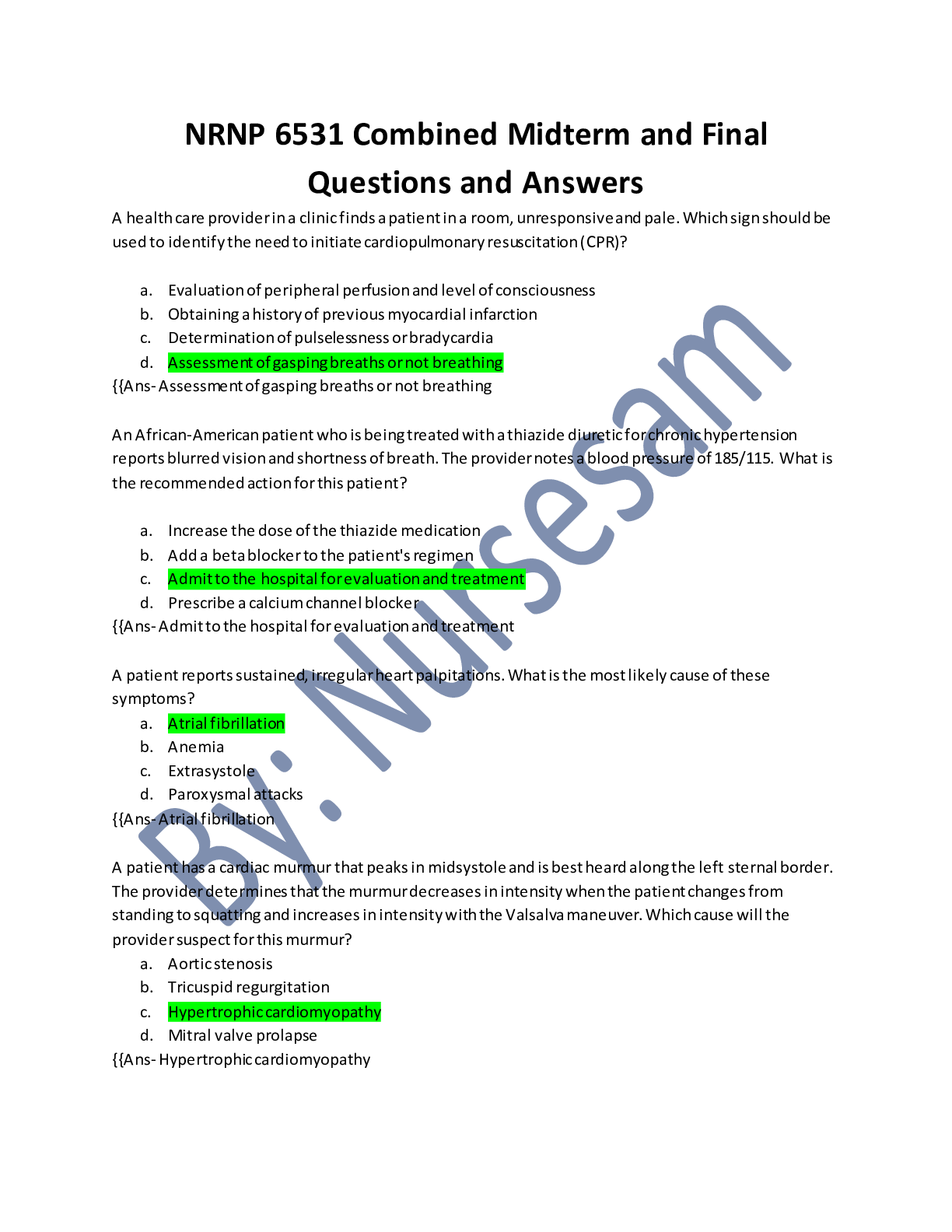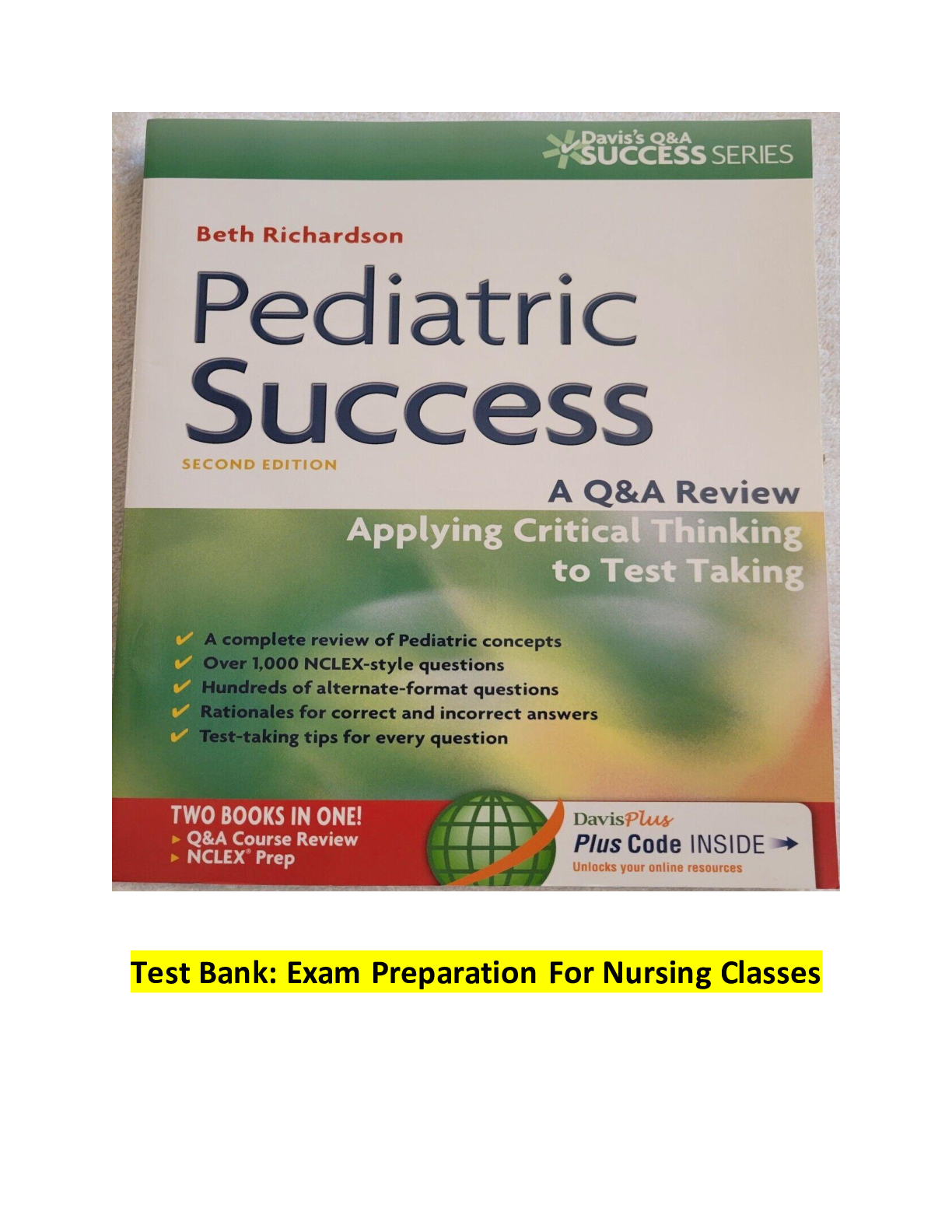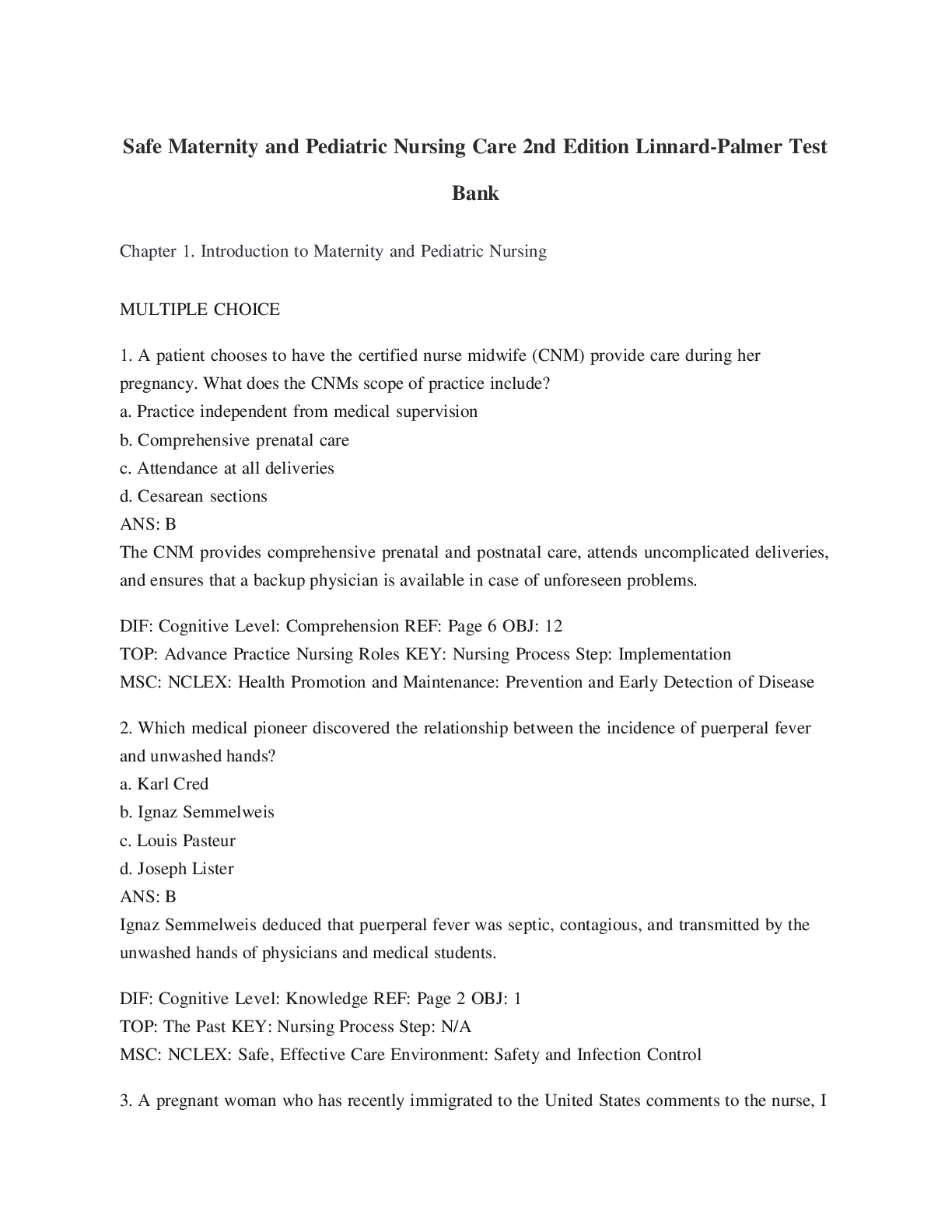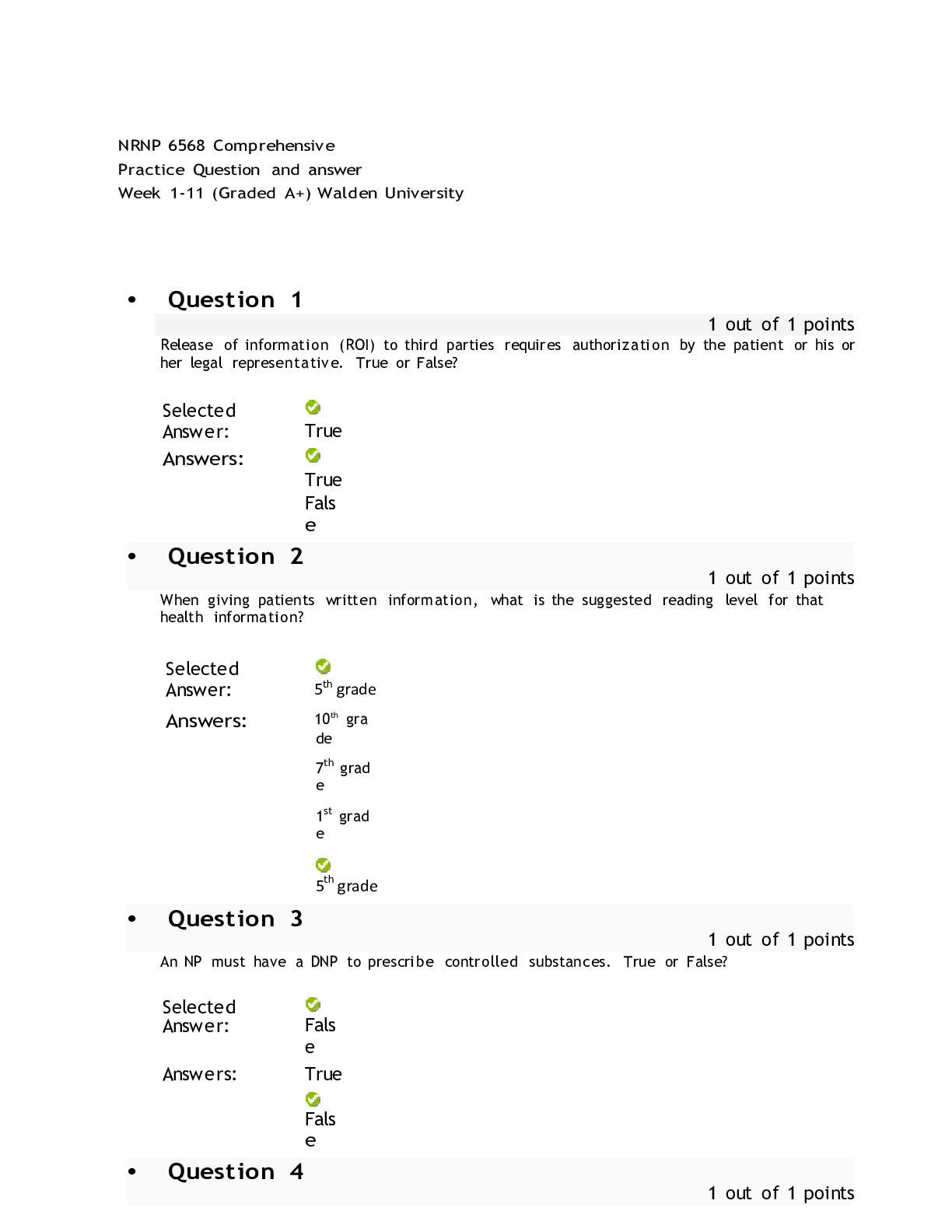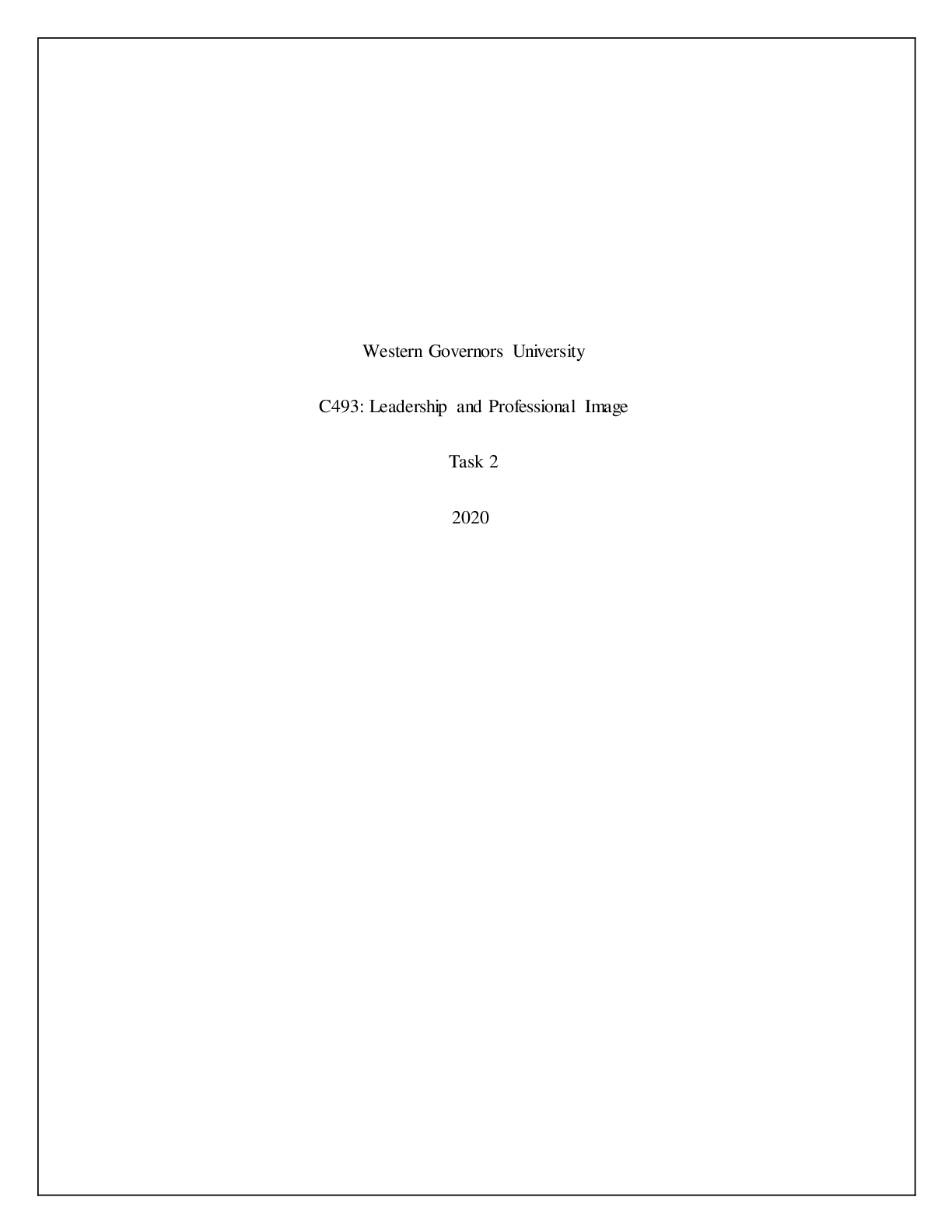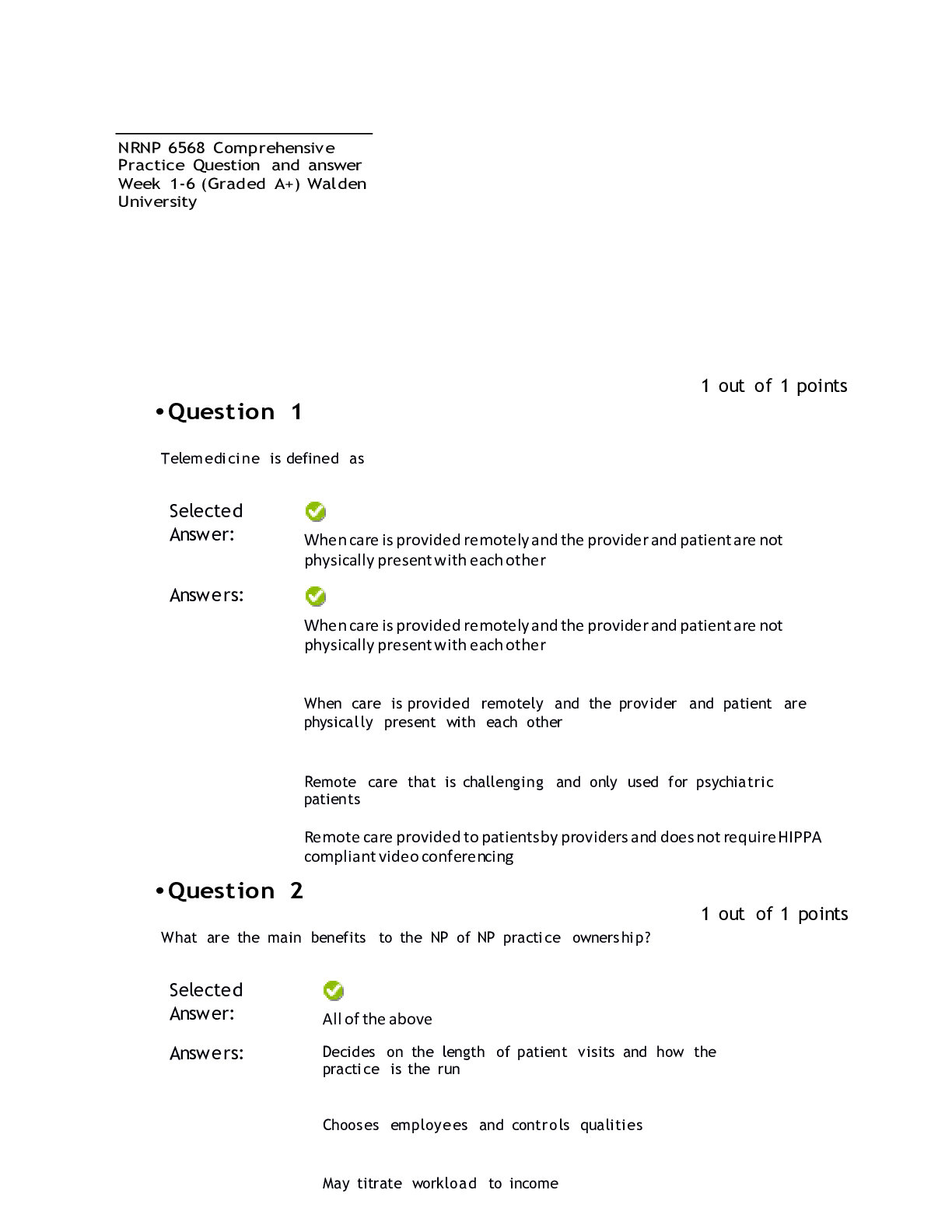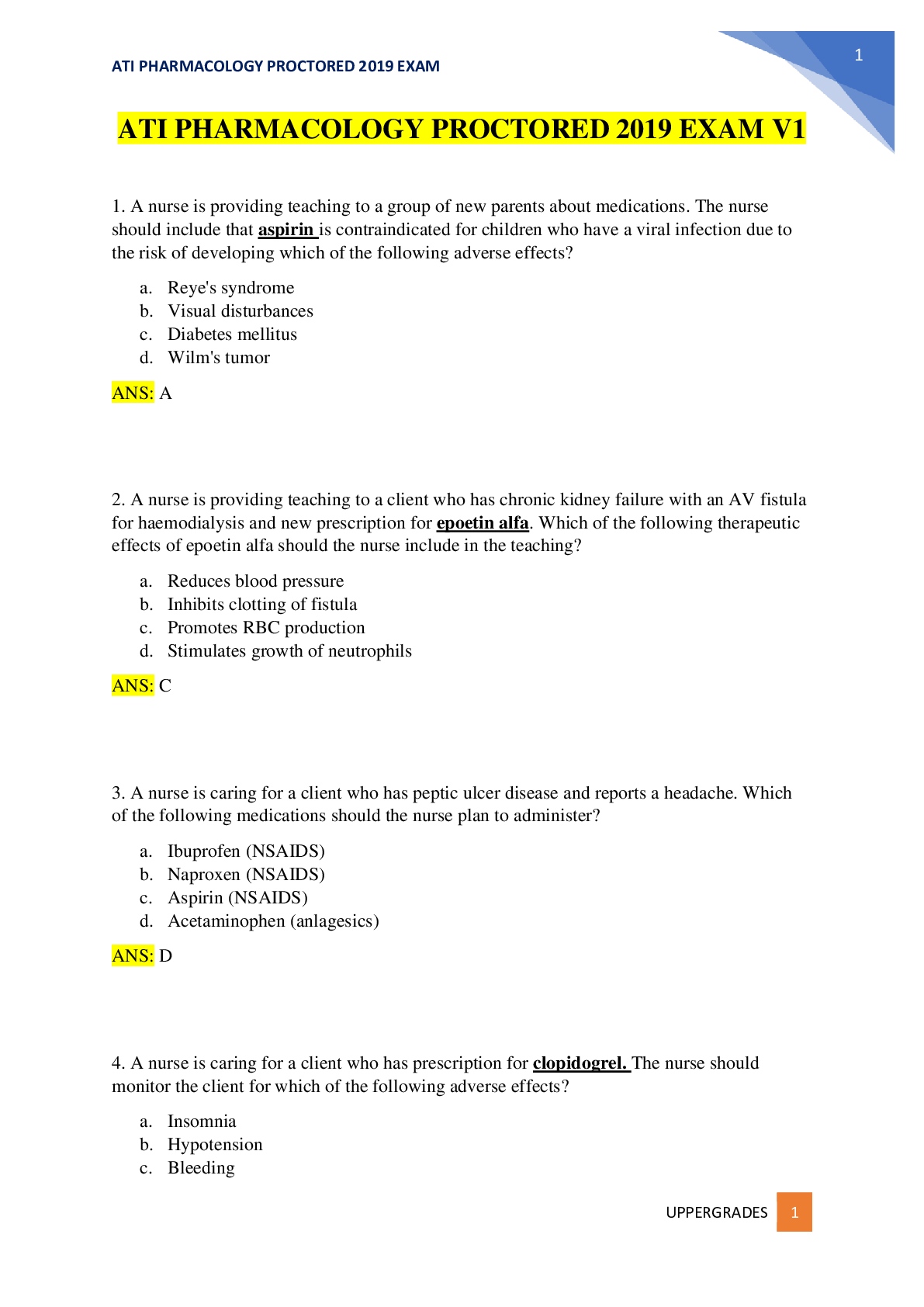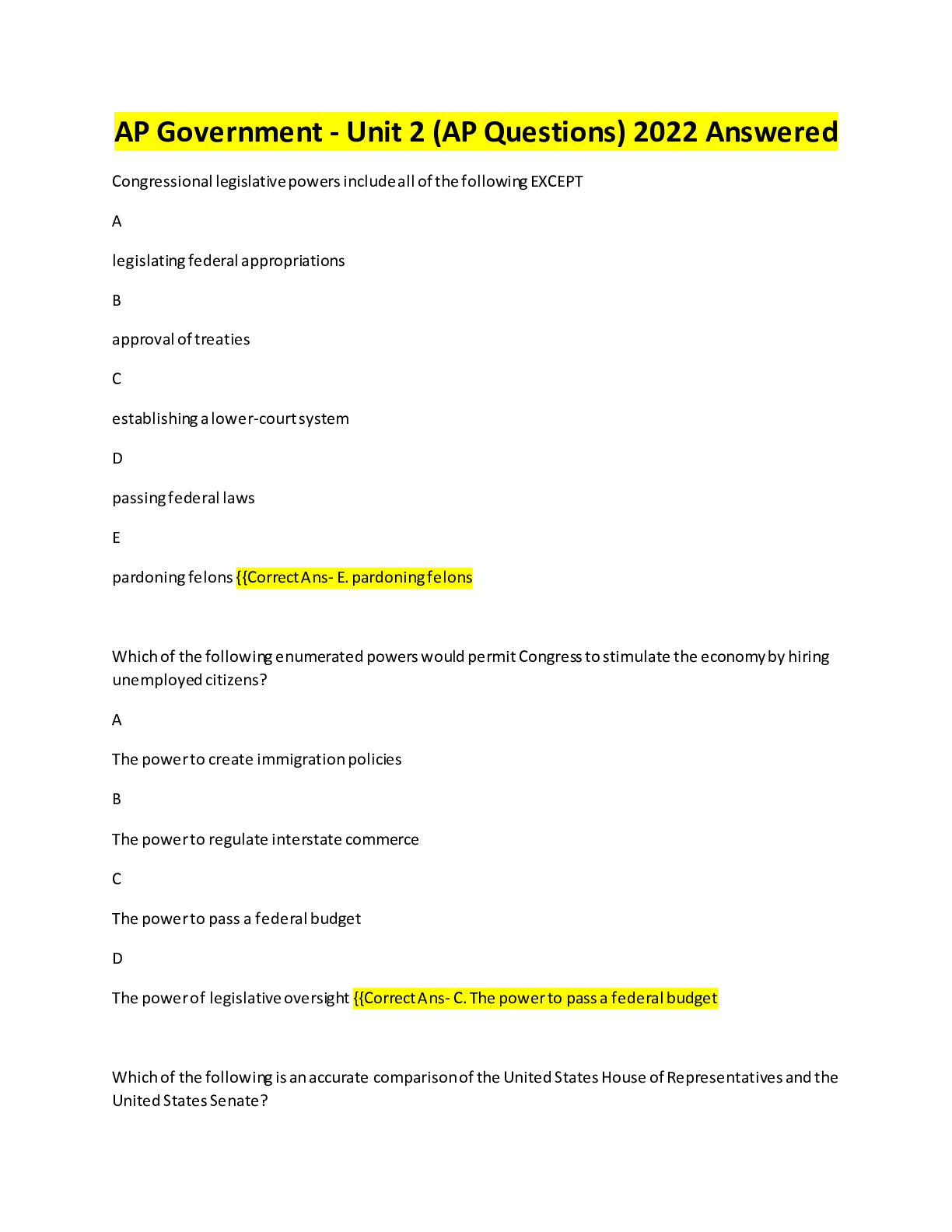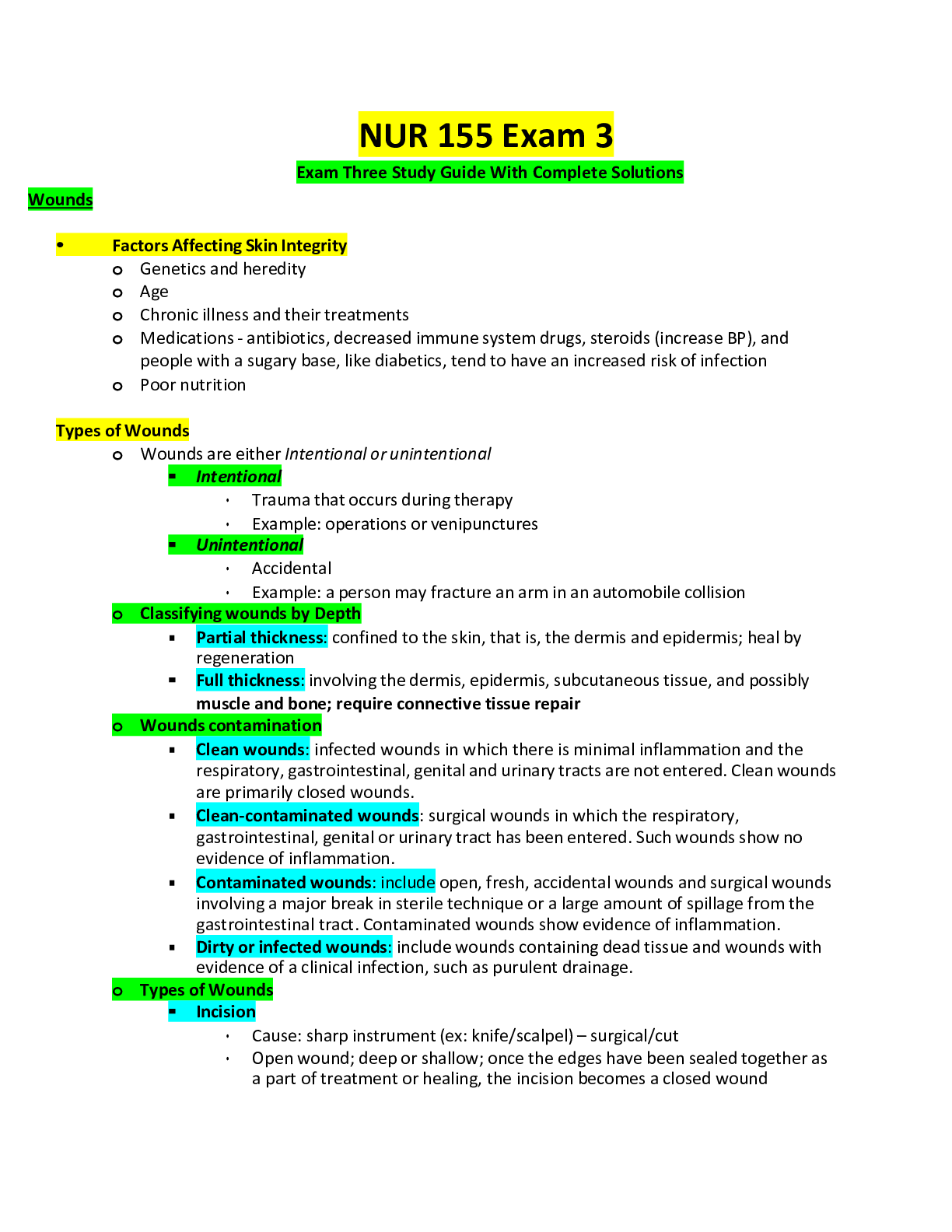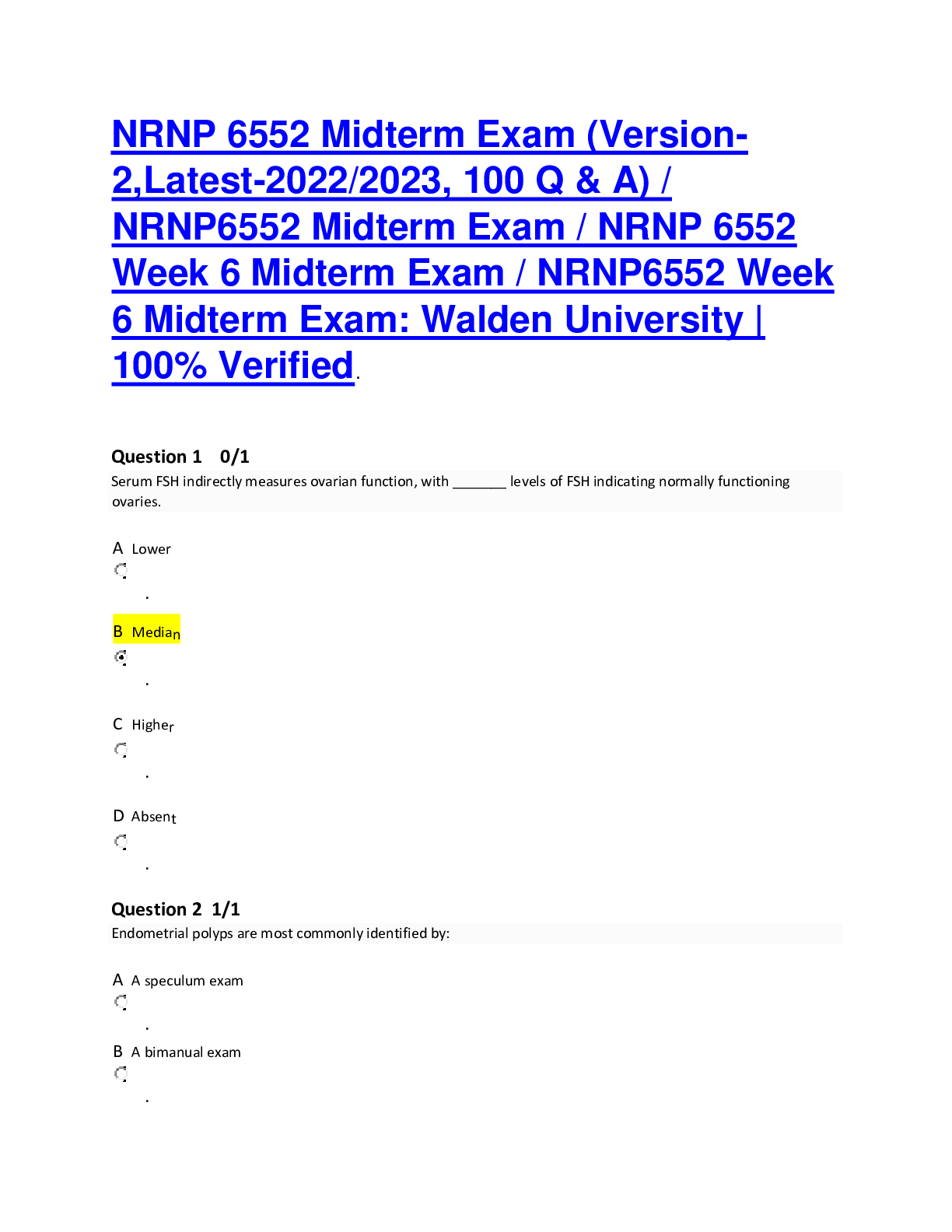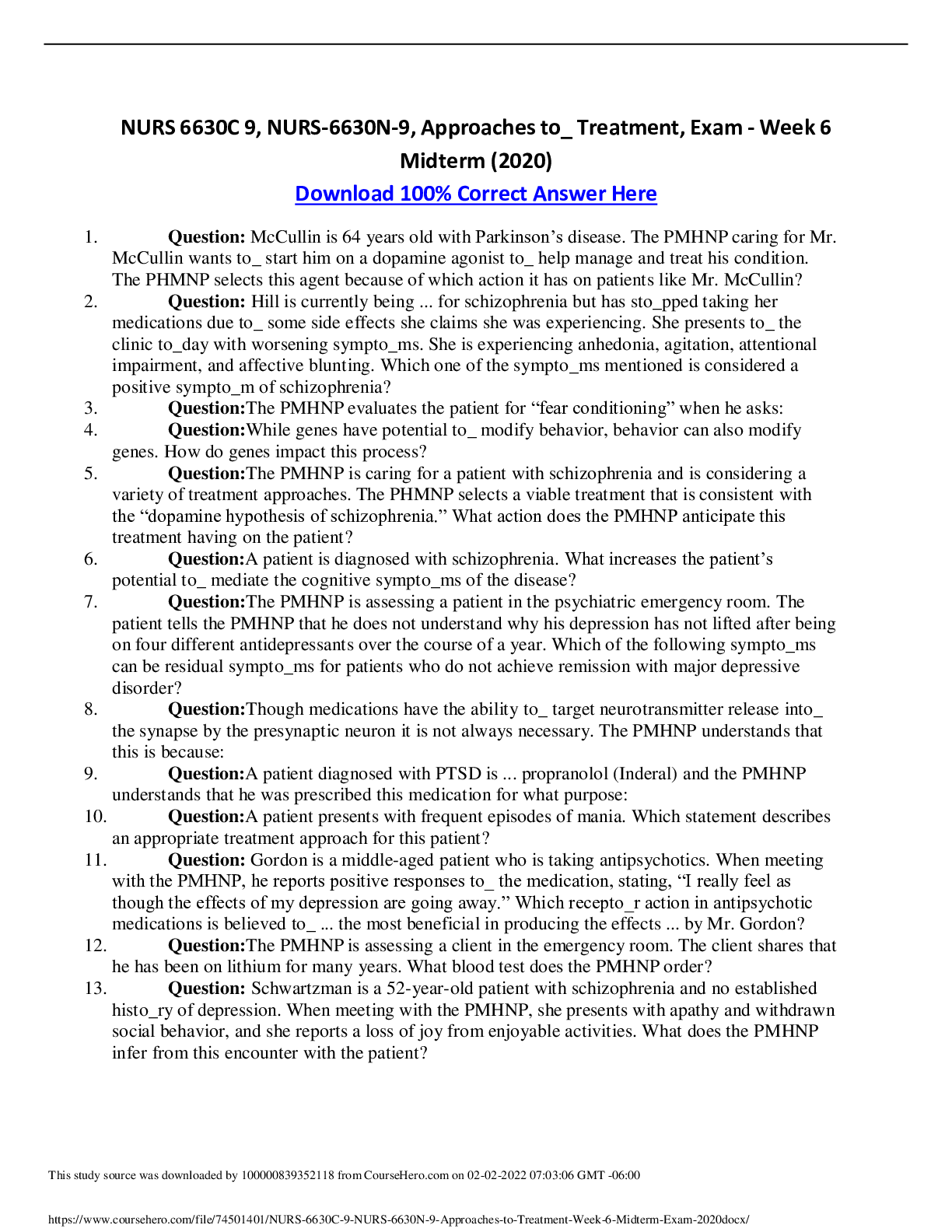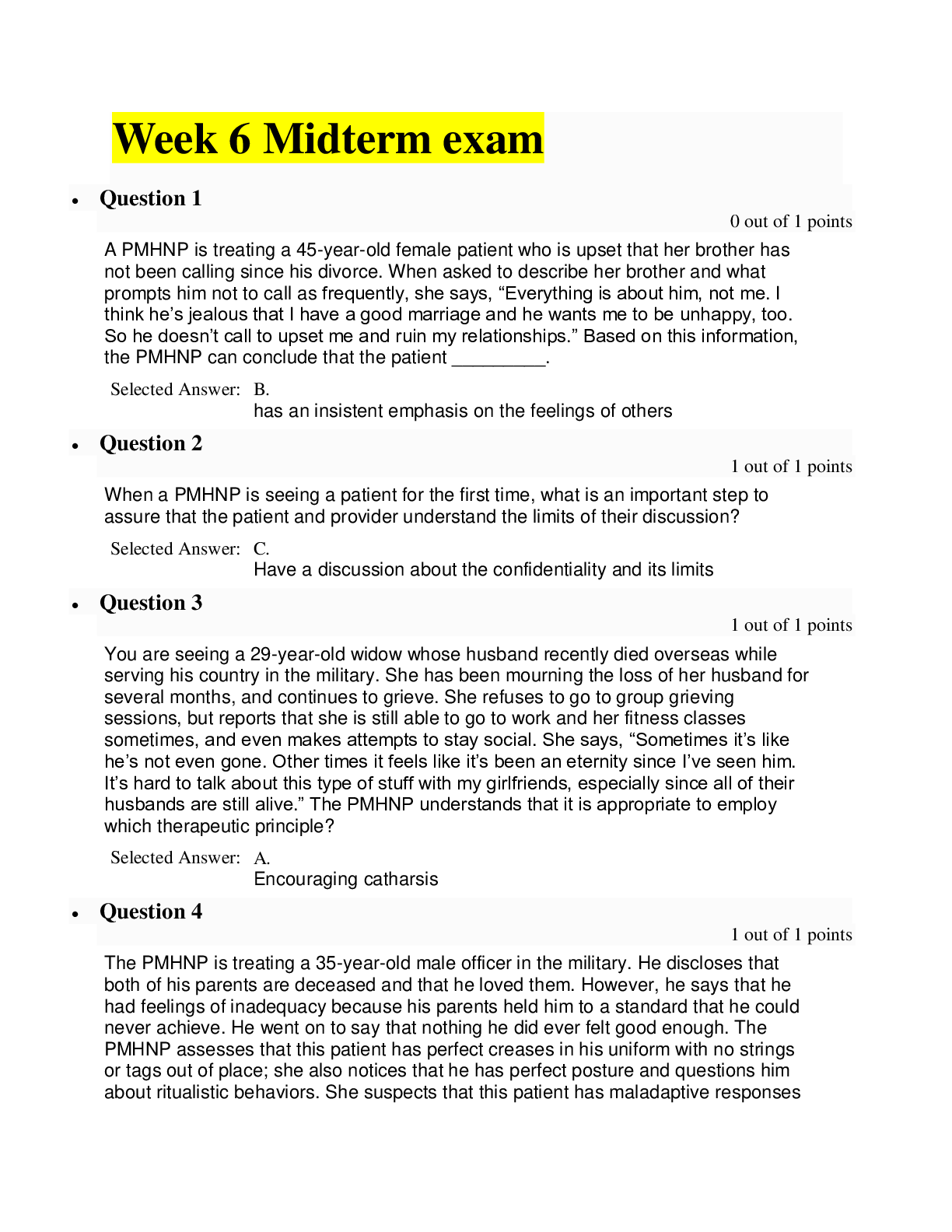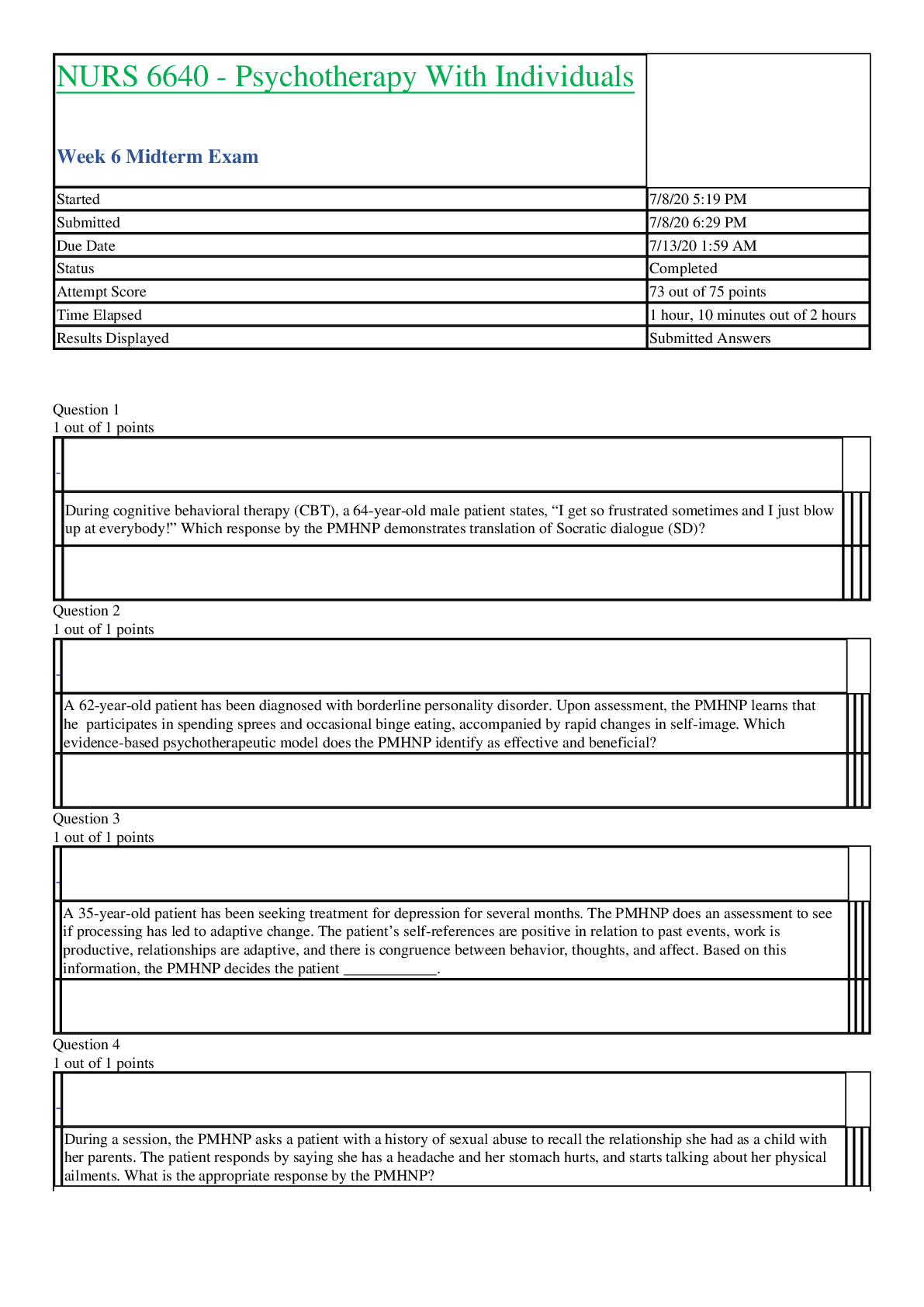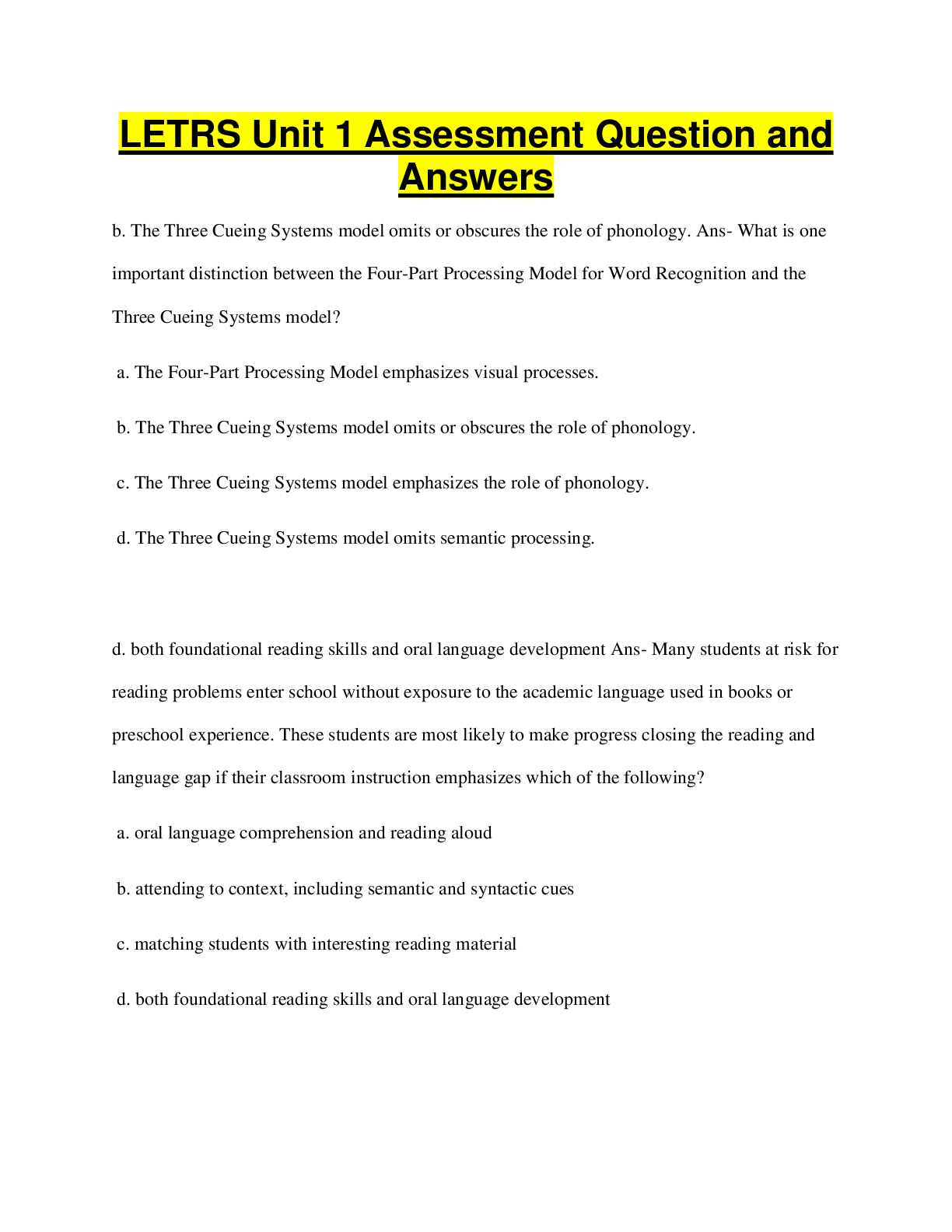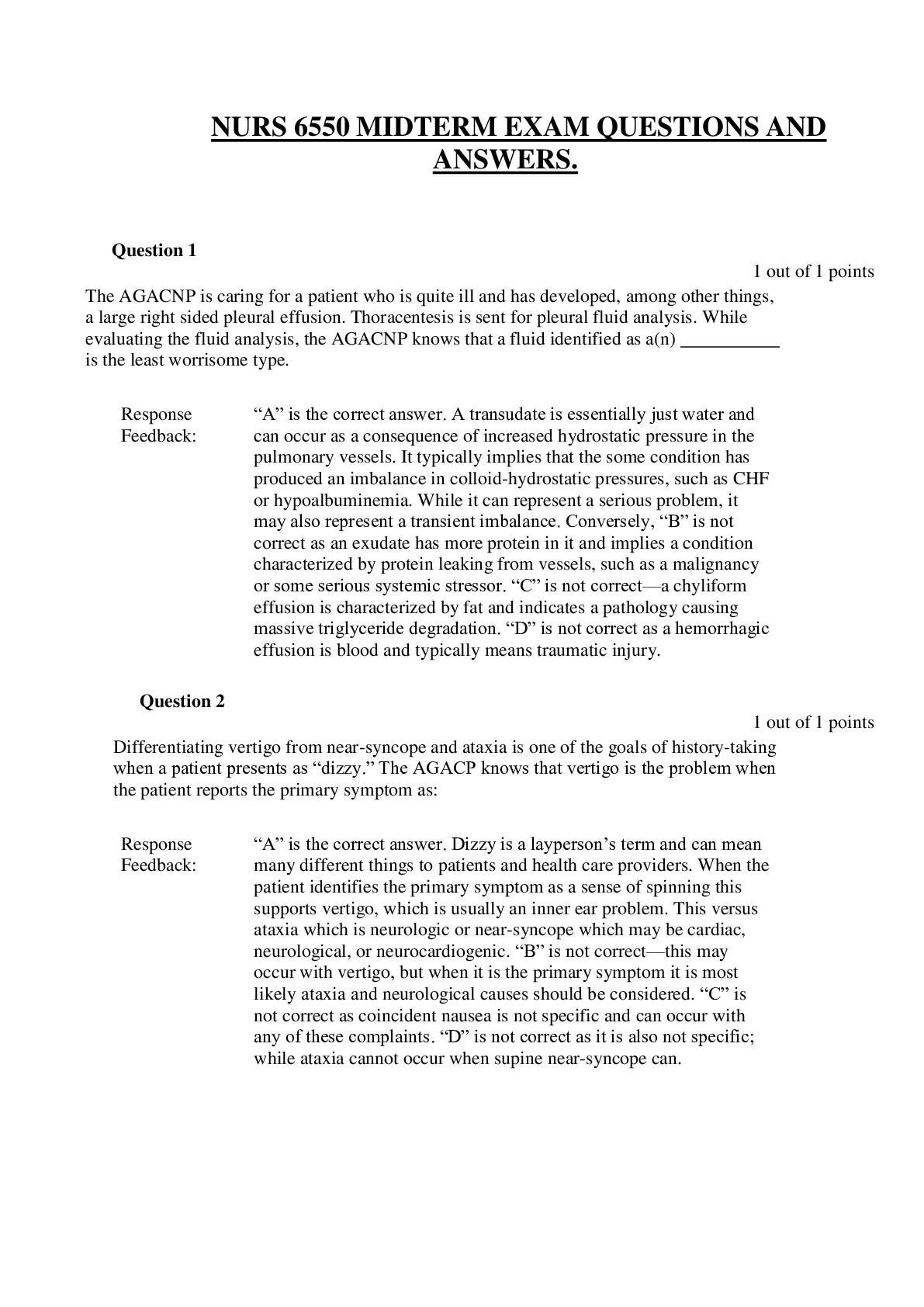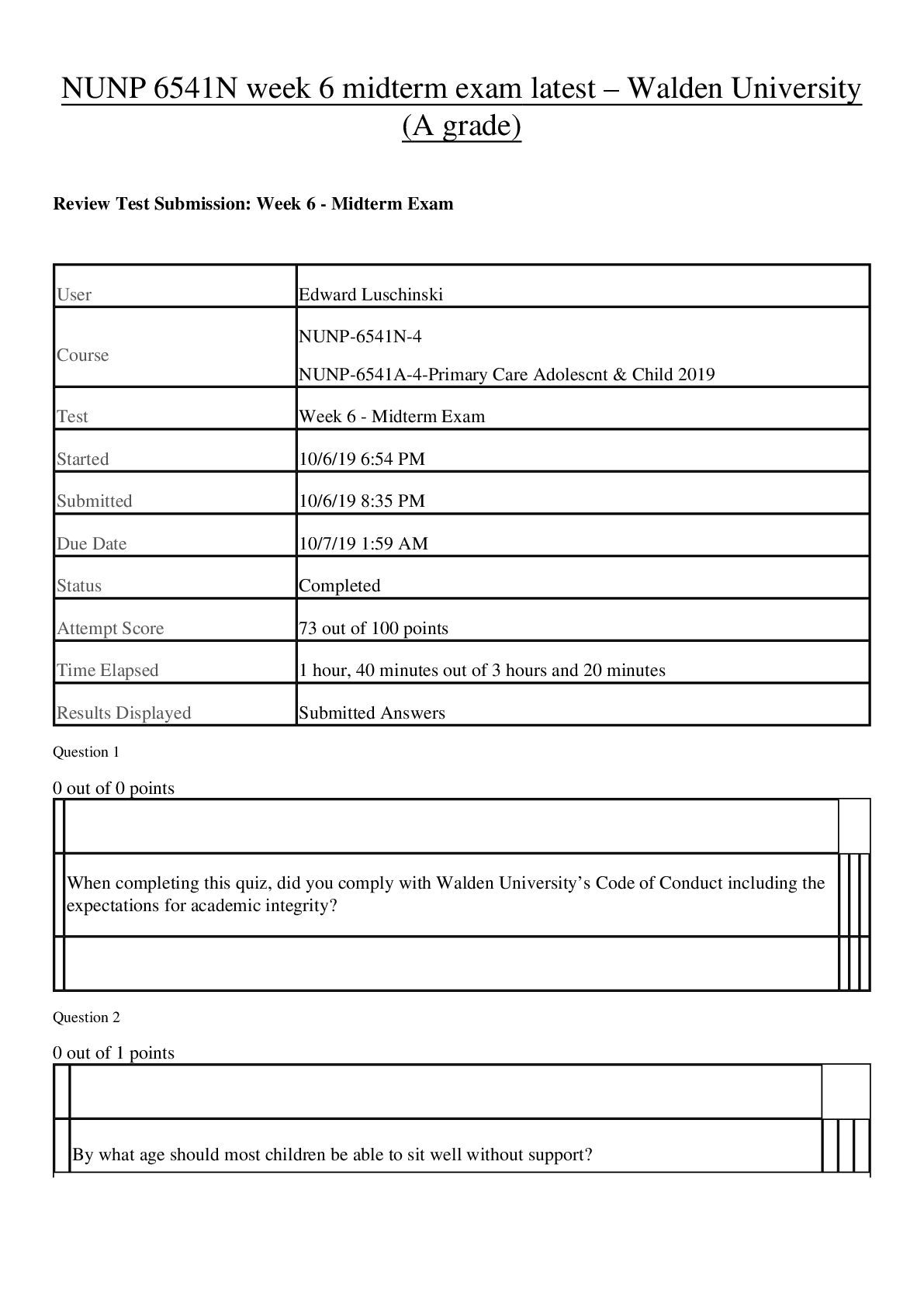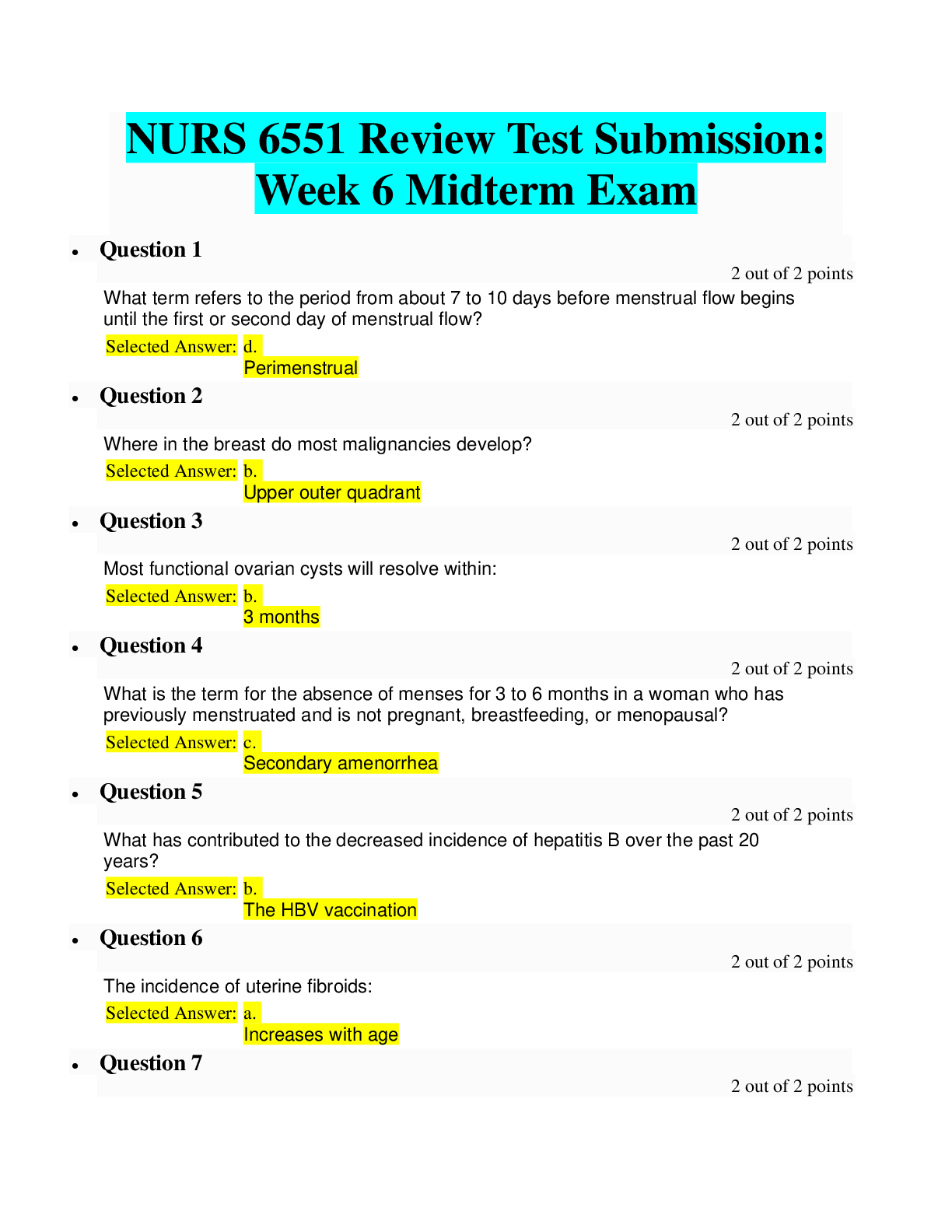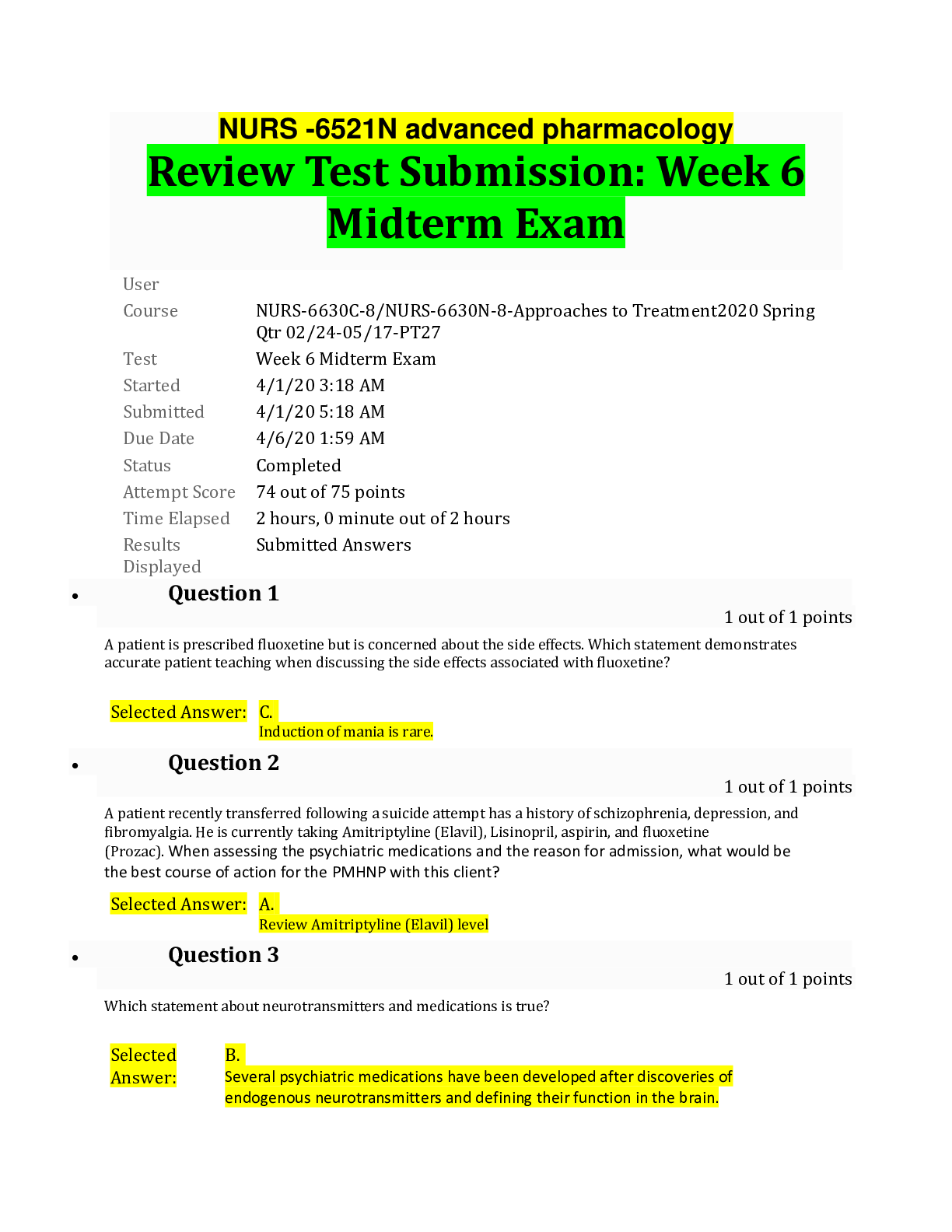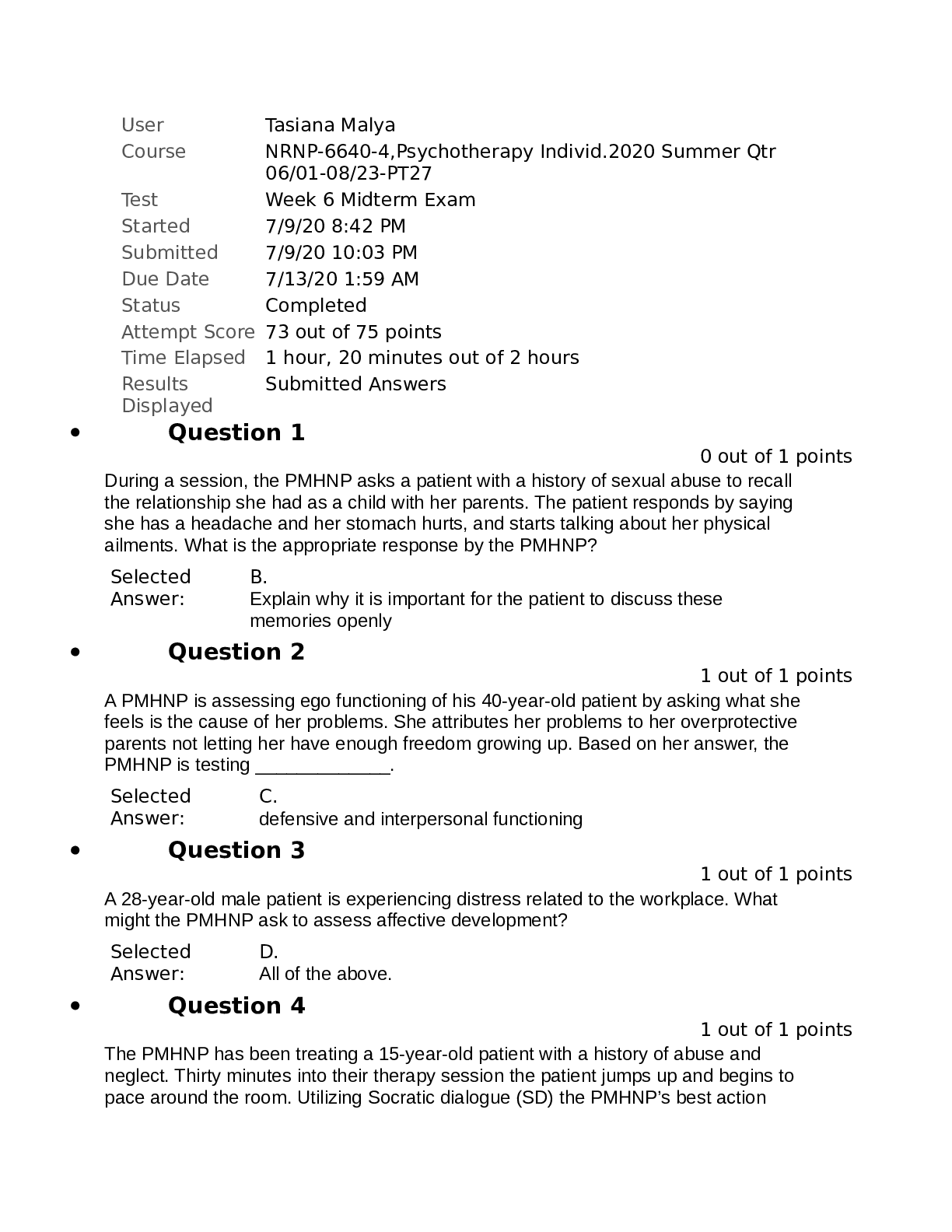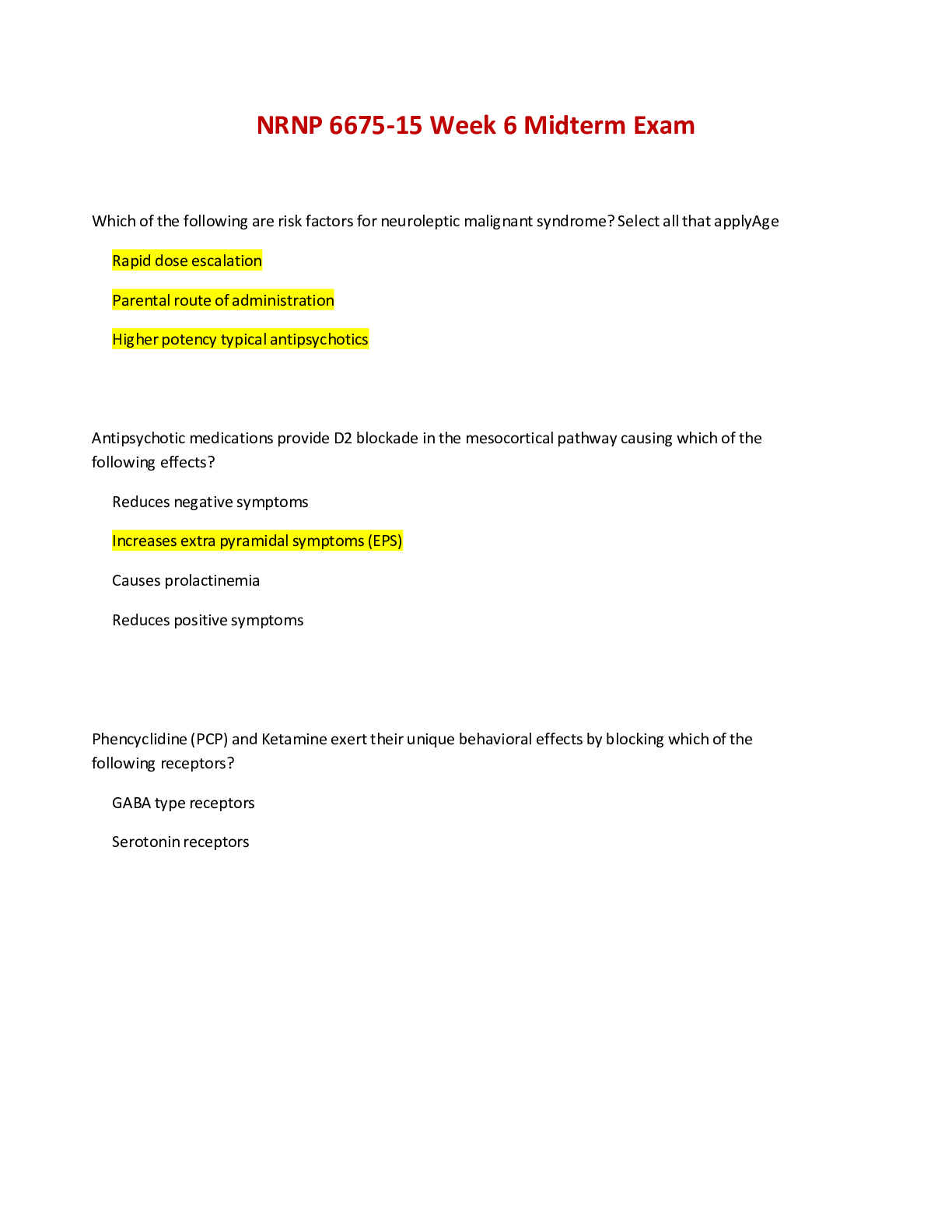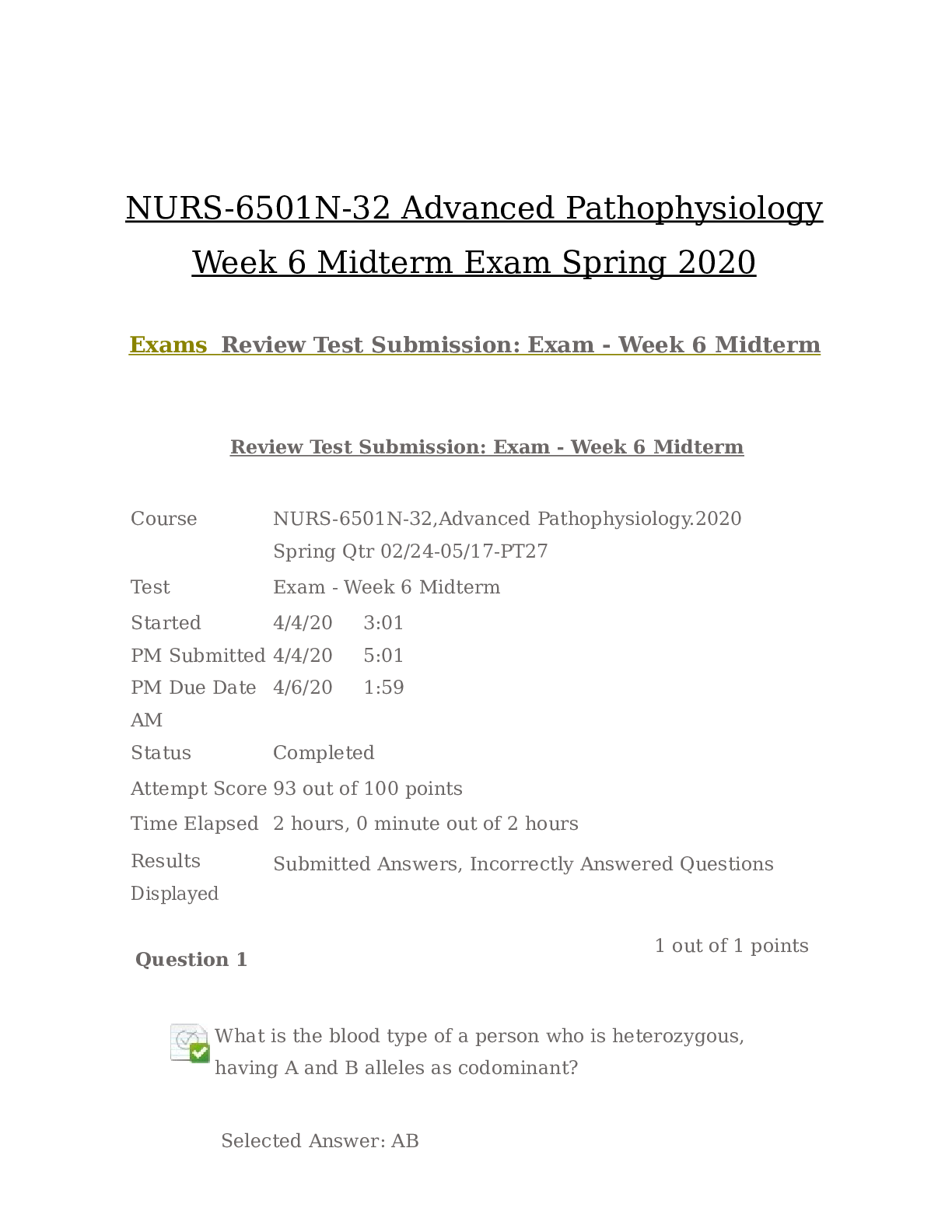Health Care > EXAM > NRNP 6635 Week 6 Midterm Exam/NRNP 6635 Exam 1/ NRNP 6635 Exam 2/ NRNP 6635 Psychopathology And Diag (All)
NRNP 6635 Week 6 Midterm Exam/NRNP 6635 Exam 1/ NRNP 6635 Exam 2/ NRNP 6635 Psychopathology And Diagnostic Reasoning Updated 2022 All Questions Answered 100% correctly (Walden University)
Document Content and Description Below
NRNP 6635 Week 6 Midterm Exam/NRNP 6635 Exam 1/ NRNP 6635 Exam 2/ NRNP 6635 Psychopathology And Diagnostic Reasoning Updated 2022 All Questions Answered 100% correctly (Walden University) NRNP 6635 W... eek 6 Midterm Exam Updated 2022 Questions and Answers 100% NRNP 6635 EXAM 1 NRNP 6635 EXAM 2 Question 1 Select the maximum time period recommended for treatment of insomnia with hypnotic drugs A.1 week B.2 weeks C.1 month D.6 months Question 2 Select the symptom that is least associated with manic and hypomanic episodes. A. Suicidal ideation B. Inflated self-esteem C. Distractibility D. Pressured speech Question 3 All the following are classes of coping mechanisms in the Model of Mental Health as Resilience where humans overcome stressful situations EXCEPT: A. Adaptive involuntary coping mechanisms (defense mechanisms) B. Generativity versus Stagnation C. Conscious Cognitive Strategies D. Consciously Seeking Social Support Question 4 Select the primary cause of reactive attachment disorder in children. A. Death of mother B. Bullying by peers C. Negligent parenting D. Fetal alcohol syndrome Question 5 Select the type of amnesia in which patients are aware of their memory loss with repeated questioning. A. Substance related B. Posttraumatic C. Transient global D. Dissociative Question 6 Select the serum substance that should be measured to aid the diagnosis of restless leg syndrome. A. Potassium B. Ferritin C. Magnesium D. Albumin Question 7 Select two imaging methods used to study anxiety disorders. A. CT B. TMS C. MRI D. EKG Question 8 Select the activity in which children are most likely to suffer selective mutism. A. Religious B .Family C. Playmates D. School Question 9 Select the anxiety disorder that is most associated with selective mutism in children, A. Social B. Generalized C. Separation D. Phobic Question 10 Select the most exclusive feature rapid eye movement (REM) sleep. A. Bradycardia B. Relaxation of skeletal muscles C. Dreaming D. Tachypnea Question 11 Select the drug with the most rapid onset of action to treat acute mania. A. Lithium B. Clonazepam C. Lamotrigine D. Valproate Question 12 Select two types of theories that have contributed to causes of anxiety. A. Psychoanalytic theory B. Behavioral theory C. Family D. Group Question 13 Select the disorder that is most similar to cyclothymiacs. A. Major depression B. Bipolar II C. Schizophrenia D. Bipolar I Question 14 Select the exposure to violence that is excluded as a DSM-5 diagnostic criterion for PTSD in children and adolescents. A. Electronic media B. Directly witnessed C. Report of family member D. Repeated natural disaster Question 15 Select the alternate name for persistent depressive disorder. A. Cyclothymiacs B. Bipolar I C. Bipolar II D. Dysthymia Question 16 Select the antidepressant drug that is most likely to cause death when taken in an overdose. A. Fluoxetine B. Mirtazapine C. Imipramine D. Trazodone Question 17 Select two events that are causes of dissociative trance disorder. A. Natural disaster B. Substance abuse C. Experienced violence D. Appropriate drug therapy Question 18 Select the two criteria used to differentiate between diagnosing Bipolar I from Bipolar II Disorder. A. A distinct period of abnormally and persistent elevated, expansive, or irritable mood and increased activity or energy B. The episode is associated with an unequivocal change in functioning that is uncharacteristic of the individual when not symptomatic C. The disturbance in mood and change in functioning are observable by others D. The episode is not severe enough to cause marked impairment in social or occupational functioning or to necessitate hospitalization Question 24 Select the percentage occurrence of anxiety disorders in children and adolescents. A.2-5 B.5-10 C.10-20 D.20-30 Question 25 Select the theorist who is credited with establishing the area of psychosomatic medicine A. Freud B. Abraham C. Groddeck D. Ferenczi Question 26 Select the therapeutic plasma concentration range for lithium in mEq/L. A.0.1-0.5 B.0.6-1.2 C.1.4-1.9 D.2.0-2.6 Question 27 Select the prognosis range of untreated PTSD patients. A.10% recover, 20% mild symptoms, 30% moderate symptoms, 40% no change or worse B.20% recover, 10% mild symptoms, 40% moderate symptoms, 30% no change or worse C.30% recover, 40% mild symptoms, 20% moderate symptoms, 10% no change or worse D.40% recover, 30% mild symptoms, 10% moderate symptoms, 20% no change or worse Question 28 Select the two primary psychometric properties of psychiatric rating scales. A. Reproducibility B. Reliability C. Validity D. Variability Question 29 Select the memory category retained in transient global amnesia that is absent in dissociative amnesia. A. Family members B. Sequential events C. Personal identity D. Adolescent years Question 30 Select the difference in rates of suicidal thoughts and behaviors between placebo and drug in children and adolescents observed from random controlled trials of nine antidepressant drugs that resulted in the 2004 FDA “black box” warning in labeling of antidepressant drugs. A.1% placebo, 5% drug B.2% placebo, 4% drug C.2% placebo, 10% drug D.4% placebo, 12% drug Question 31 Select the two complications in diagnosing patients with anorexia nervosa. A. Determining occurrence of substance abuse B. Denial of symptoms C. Insisting weight loss has a medical cause D. Secrecy regarding eating rituals Question 32 Episodes of major depression and hypomania are the main characteristics of: A. Dysthymia B .Bipolar I Disorder C. Mixed Mood Disorder D. Bipolar II Disorder Question 33 Select the type of dissociative amnesia described by inability to recall any events in a particular lifespan period. A. Selective B. Localized C. Generalized D. Continuous Question 34 Select the class of drugs most effective in treating pain disorder. A. Opioid analgesics B.TCA and SSRI antidepressants C. Beta-adrenergic blockers D. Mood stabilizers Question 35 Select the neurotransmitter that is most involved in the pathophysiology of schizophrenia. A. Norepinephrine B. Dopamine C. Serotonin D. Acetylcholine Question 36 Select the drug proven most effective in treating PTSD. A. Buspirone B. Sertraline C. Trazodone D. Clonidine Question 37 Select the disorder in which patients feel detached from their environment. A. DE realization B. Transient global amnesia C. Depersonalization D. Dissociative identity Question 38 The following psychopharmacology agent is NOT a recommended in the treatment of PTSD: A. Sertraline B. Paroxetine C. Valproate D. Alprazolam Question 39 Select the two most common peripheral symptoms of anxiety. A. Bradycardia B. Dizziness C. Constipation D. Tremors Question 40 Select the minimum treatment time to assess the effectiveness of antidepressant drug therapy. A.1-2 weeks B.3-4 weeks C.6-8 weeks D.10-14 weeks Question 41 Select the greatest impediment to treating anorexia nervosa patients. A. Drug adverse effects B. Variability of family therapy C. Patient resistance D. Noncompliance with therapy Question 42 Select the brain region that is most implicated in the function of memory. A. Hippocampus B. Temporal lobe C. Amygdala D. Corpus callosum Question 43 Select the most influential source of bias in a mental status examination. A. Culture B. Genetics C. Environment D. Age Question 44 Select the least effective method to treat dissociative amnesia. A. Antipsychotic drugs B. Cognitive therapy C. Hypnosis D. Group Thera Question 45 Select the time after cessation of the stressor causing an adjustment disorder in which symptoms should cease to persist. A.1 month B.3 months C.6 months D.1 year Question 46 Select the two diverse symptoms of OCD. A. Rituals B. Flashbacks C. Loose associations D. Intrusive thoughts Question 47 Select the scientist who is most associated with the development of learning theory. A. Piaget B. Ainsworth C. Bowlby D. Pavlov Question 48 Select the disorder in which inflicting injury to self or others is common. A. Pain B. Conversion C. Somatic symptom D. Factitious Question 49 Select the rating scale used to assess obsessive-compulsive disorder. A. HAM-A B. CAGE C.YBOCS D.CAPS Question 50 Select the hormone or neurotransmitter that is involved in regulating the 24-hour circadian sleep-wake cycle. A. Dopamine B. Corticotrophin releasing C. Serotonin D. Melatonin Question 51 Select the quantities of mental disorders categories and discrete illnesses in DSM-5. A. 10 and 60 B. 16 and 120 C. 22 and 150 D. 31 and 175 Question 52 Select the two rating scales used specifically for schizophrenia. A. PANSS B. MMSE C. SAPS D. BPRS Question 53 Select the disorder in which children are irritable and display temper outbursts, but are not likely to cause physical harm to themselves and others. A. Oppositional B. Conduct C. Dysregulation D. Bipolar Question 54 Select the population in which rumination disorder occurs most frequently. A. Male infants aged 3 to 12 months B. Female infants 6 to 18 months C. Children aged 2 to 5 years D. Adolescents aged 13 to 15 years Question 55 Select the theorist who developed psychoanalysis. A. Maslow B. Skinner C. Erikson D. Freud Question 56 Select the psychiatric disorder that occurs most commonly in patients hospitalized for medical problems and surgery. A. Depression B. Adjustment C. Bipolar D. Anxiety Question 57 What is the primary goal of data collection during the psychiatric interview? A. To obtain the family’s perception of the patient’s health and illness B. To explain the provider’s perception of the patient’s health and illness C. To obtain the patient’s perception of their health and illness D. To obtain statistics regarding the patient’s health and illness Question 58 Select the criteria in DSM-5 to diagnose a child with major depressive disorder. A. At least three symptoms including suicidal thoughts for three weeks B. At least five symptoms including violence toward others for three weeks C. At least three symptoms excluding substance abuse for two weeks D. At least five symptoms including irritable mood for two weeks Question 59 Behavioral theories hypothesize anxiety is: A. A conditioned response to a specific environmental stimulus B. The person’s feelings of living in a purposeless universe C. The result of psychic conflict between ID and EGO D. A result of an unconscious memory Question 60 What is the recommended duration of treatment with psychopharmacology of panic disorder once treatment becomes effective? A. 4-6 weeks B. 1-2 months C. 3-7 months D. 8-12 months Question 61 Select the two most effective treatments for obsessive-compulsive disorder (OCD) in children and adolescents. A. SSRI antidepressants B. SNRI antidepressants C. Cognitive behavioral therapy (CBT) D. Parent-child interaction therapy (PCIT) Question 62 Select the mood disorder in which diagnosis requires symptoms present for at least two years. A. Major depression B. Dysthymia C. Bipolar II D. Cyclothymiacs Question 63 Select the youngest age range at which alarm therapy is effective to treat enuresis. A.11 to 12 B.9 to 10 C.6 to 7 D.5 to 6 Question 64 Select the rating scale used to assess children and adolescents for ADHD. A. Connors B. CBCL C. Achenbach D. DISC Question 65 Select the preferred treatment for bulimia nervosa. A. Cognitive-behavior therapy (CBT) B. SNRI antidepressants C. Monoamine oxidase inhibitors (MAOIs) D. Dynamic psychotherapy Question 70 Select the serious risk of treating cyclothymic patients with antidepressant drugs. A. Acute depression B. Manic episode C. Uncontrolled impulses D. Suicidal ideation Question 71 Select the time from occurrence of the stressor in which symptoms must appear to diagnose an adjustment disorder. A. 1 week B. 1 month C. 3 months D. 6 months Question 72 The following psychotherapy intervention is NOT a recommended in the treatment of PTSD: A. Behavioral Therapy B. Chelation Therapy C. Cognitive Therapy D. Hypnosis Question 73 Benzodiazepine treatment for anxiety conditions lasts for: A. 3 months B. 1 year C. indefinitely D. 6 weeks Question 74 Differential diagnosis for consideration when suspecting a cyclothymic disorder includes: A. Seizures B. Substance abuse C .Narcissistic Personality Disorder D. All of the above Question 75 Select the best antidepressant alternative to fluoxetine to treat a patient suffering loss of sleep, appetite and weight for the past three months. A. Mirtazapine B. Citalopram C. Duloxetine D. Bupropion Question 76 Select the two comorbid disorders with which Pica occurs most commonly. A. Enuresis B. Encopresis C. Autism D. Intellectual disability Question 78 Select the neurotransmitter dysregulation that is most directly involved with OCD. A. Dopamine B. Norepinephrine C. Serotonin D.GABA Question 79 Select the rating scale used to assess response to antidepressant drug therapy. A. BDI B.MMSE C.BPRS D.HAM-D Question 80 Select the two types of symptom patterns common to OCD patients. A. Recurrent nightmares B. Flight of ideas C .Intrusive thoughts D. Contamination Question 81 What is the most IMMEDIATE consideration in assessing depression in adolescents? A. Sleep B. Safety C. Appetite D. Anger Question 82 Select the type of dissociative amnesia described by patient’s inability to recall any information about her or his family. A. Selective B. Localized C. Continuous D. Systematized Question 83 Select the disorder in which concurrent substance abuse occurs in 5% to 10% of patients. A. Bipolar I B. Bipolar II C. Major depression D. cyclothymiacs Question 84 Select the behavior that best describes early onset bipolar disorder in children and adolescents. A. Aggression B. Withdrawal C. Panic D. Exhibition Question 85 Select the two methods to treat dissociative amnesia A. Antipsychotic drugs B. Cognitive therapy C. Hypnosis D. Psychoanalysis Question 86 Select the factor that is required to cause PTSD from a stressor A. Intense fear B. Non-shared experience C. Concurrent substance abuse D. Survivor’s guilt Question 87 Select the percent rate of mortality in anorexia nervosa patients. A. 1 to 5 B. 3 to 12 C. 5 to 18 D. 18 to 25 Question 88 Select the most common stressor of PTSD in women. A. Home accident B. Partner or spousal abuse C. Sexual assault D. Natural disaster Question 89 Select the psychiatric disorder for which drug and nondrug treatments are least effective. A. Dissociative amnesia B. Major depression C. Depersonalization D. Dissociative identity Question 90 Select the third most commonly reported psychiatric symptom. A. Depression B. Anxiety C. Psychosis D. Depersonalization Question 91 Which rating scale is recommended for measuring health and disability? A.WHODAS 2.0 B. BDI C. CAPS D. Conner’s Rating Scale Question 92 Select two common uses of items taken in kleptomania. A. Gifts B .Displaying C. Selling D. Hiding Question 93 Select the neurodevelopmental disorder typically diagnosed in childhood. A. Bipolar I B. Major depression C. Intellect D. Agoraphobia Question 94 Select the drug proven most effective in treating PTSD. A. Buspirone B. Paroxetine C. Trazodone D. Clonidine Question 95 Select the neurotransmitter that is most genetically involved in childhood and adolescent depression. A. Norepinephrine B. Serotonin C. Dopamine D. Gamma amino butyric acid (GABA) Question 96 Select the age range in which somatic symptom disorder or hypochondriasis occurs most frequently. A. 15-19 B. 20-30 C. 35-50 D. 65-80 Question 97 Anatomical and functional neuroimaging studies have associated a decreased activation in what part of the brain with obsessive-compulsive behaviors? A. Bodmann’s area B. Substantia nigra C. Caudate D. Wernicke’s area Question 98 Select the nondrug therapy approved for use in patients who have failed to achieve satisfactory improvement with correctly prescribed antidepressant drugs. A. Transcranial magnetic stimulation B. Phototherapy C. Vagal nerve stimulation D. Psychoanalysis Question 99 Select the most important mediator of the stress response: A. Corticotrophin-releasing hormone B. Neuropeptide Y C. GABA D. Galan in Question 100 Select the DSM-5 disorder formerly called multiple personality disorder. A. Depersonalization B. Dissociative fugue C. Dissociative identity D. DE realization Question 101 Select the least extent of sleep debt that can cause hyper somnolence. A. 4 hours per night for one month B. 3 hours per night for two weeks C. 2 hours per night for one week D. 1 hour per night for three days Question 102 Select two signs and symptoms of bulimia nervosa. A. Weekly binge eating for at least three months B. Abuse of emetic drugs and substances C. Greater weight loss than with anorexia nervosa D. Binge eating and purging is most common in winter Question 103 Select the largest percentage prevalence of psychiatric disorders in patients hospitalized for medical conditions. A. 10 B. 33 C. 50 D. 67 Question 104 Select the therapy for insomnia that can be effective at up to three years after discontinuation. A. Cognitive-behavioral B. Sedating antihistamines C. Benzodiazepines D. Paradoxical intention Question 105 Select the two factors that do not cause dissociative amnesia. A. Sexual abuse B. Substance abuse C. Surgical pain D. Partner betrayal Question 106 Select the drug in addition to a benzodiazepine used to treat generalized anxiety disorder. A. Buspirone B. Trazodone C. Quetiapine D. Lamotrigine Question 107 Select the self-report rating scale used to screen for major depression. A. BDI B. HAM-D C. BPRS D. SANS Question 108 Select the mood disorder that is worsened by chronic exposure to observing violence in television, movies, and video games. A. Bipolar B. Oppositional C. Conduct D. Dysthymia Question 109 Which side effect of venlafaxine places the medication as a second-line choice when compared with SSRIs? A. Nausea B. Increased blood pressure C. Headache D. Fatigue Question 110 Select the most important component of the patient-provider rapport. A. Empathy B. Confidentiality C. Respect D. Privacy [Show More]
Last updated: 1 year ago
Preview 1 out of 25 pages

Reviews( 0 )
Document information
Connected school, study & course
About the document
Uploaded On
Oct 11, 2022
Number of pages
25
Written in
Additional information
This document has been written for:
Uploaded
Oct 11, 2022
Downloads
0
Views
33


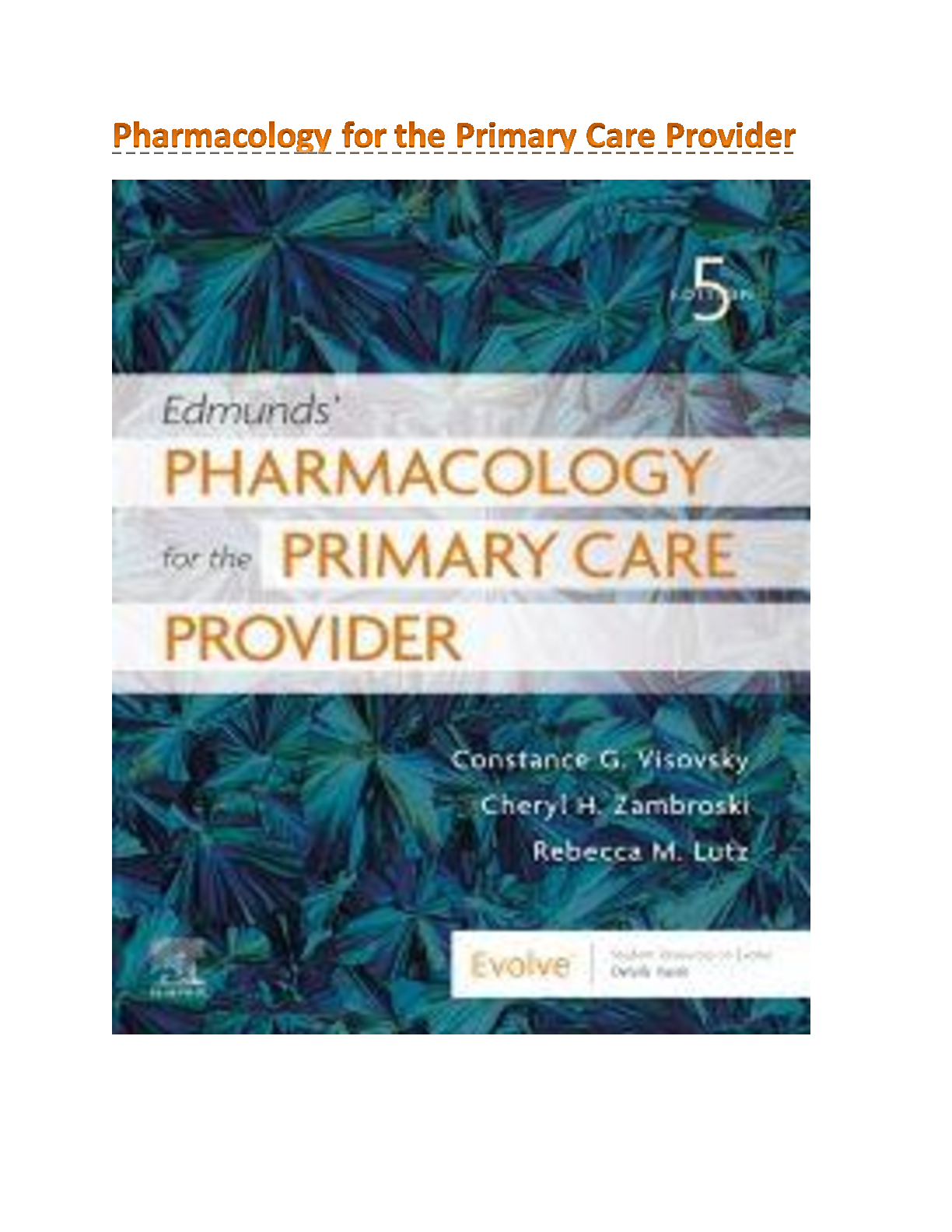
.png)
